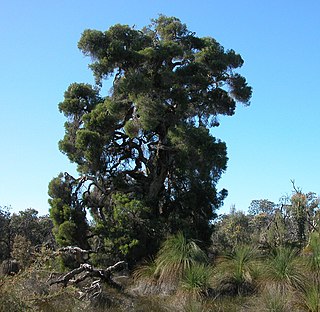
Melaleuca preissiana, commonly known as stout paperbark, modong or moonah, is a plant in the myrtle family, Myrtaceae and is endemic to coastal areas of southwest Australia. It is a shrub or small tree with papery bark, small leaves and spikes of usually white flowers. It occurs chiefly in areas that are seasonally wet.
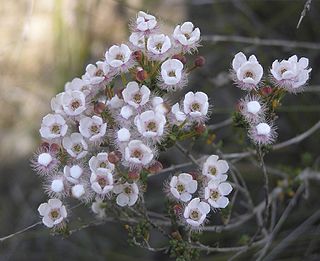
Verticordia habrantha, commonly known as hidden featherflower, is a flowering plant in the myrtle family, Myrtaceae and is endemic to the south-west of Western Australia. It is a slender shrub with short, leafy side-branches and long flowering stems with rounded heads of mostly white flowers. Its hairy sepals are mostly hidden by the round, unfringed petals, and as a result, the plant looks like shrubs in the genus Chamelaucium, to which it is closely related.

Hypocalymma strictum is a species of shrub in the myrtle family Myrtaceae, endemic to the south west of Western Australia.
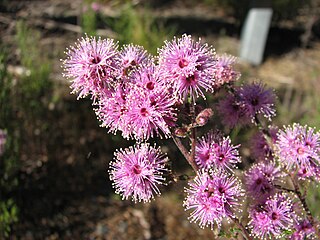
Kunzea parvifolia, commonly known as the violet kunzea, is a flowering plant in the myrtle family, Myrtaceae and is endemic to eastern Australia. It is a wiry shrub with small, narrow leaves and clusters of pink to purple flowers in spring.

Thryptomene saxicola, commonly known as rock thryptomene, is a species of flowering plant in the family Myrtaceae and is endemic to the south-west of Western Australia. It is a spreading shrub with small oval or egg-shaped leaves and pale pink flowers arranged in leaf axils. It is hardy plant, common in cultivation, sometimes as "Payne's hybrid" or Thryptomene paynei.

Melaleuca holosericea is a plant in the myrtle family Myrtaceae which is endemic to the south-west of Western Australia. It is a small, rare shrub similar to other pink-flowered species in the Melaleuca scabra group.
Melaleuca manglesii is a plant in the myrtle family Myrtaceae and is endemic to a small area in the south-west of Western Australia. It is a low, spreading shrub which produces large numbers of heads of purple flowers with yellow tips in spring.

Melaleuca spathulata is a shrub in the myrtle family, Myrtaceae, and is endemic to the south-west of Western Australia. It is a well known garden shrub featuring dark green leaves against light-coloured foliage, many twisted branches and profuse heads of bright pink "pom pom" flower heads in spring or early summer.

Melaleuca subtrigona is a plant in the myrtle family, Myrtaceae, and is endemic to the south-west of Western Australia. It is a small shrub with warty leaves and heads of "pom-pom" flowers in spring and early summer.
Verticordia lehmannii is a flowering plant in the myrtle family, Myrtaceae and is endemic to the south-west of Western Australia. It is slender shrub with only a few branches, well-spaced, oppositely arranged leaves and small heads of pale pink to silvery flowers with a dark pink centre.

Agonis theiformis is a species of flowering plant in the family Myrtaceae and is endemic to the southwest of Western Australia. It is a shrub with elliptic to egg-shaped, sometimes broadly egg-shaped leaves, and clusters of white flowers with mostly 15 to 20 stamens opposite the sepals, the fruit a spherical cluster of cup-shaped capsules.

Kunzea micrantha is a flowering plant in the myrtle family, Myrtaceae and is endemic to the south west of Western Australia. It blooms between September and December producing pink-purple to white-cream flowers. A widespread and variable species, it is difficult to distinguish from K. praestans and from K. micromera where their range overlap.
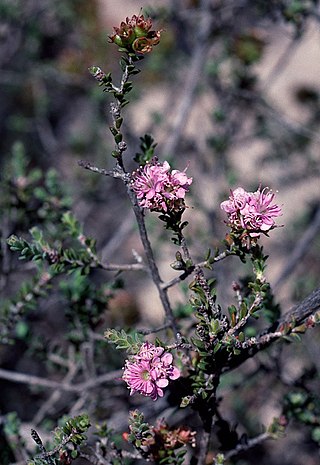
Kunzea micromera is a flowering plant in the myrtle family, Myrtaceae and is endemic to the south west of Western Australia. It is a small, sparse shrub, similar in some respects to K. micrantha but has shorter, more rounded sepal lobes. It produces groups of pink flowers on the ends of a few long shoots in spring.

Kunzea pauciflora, the Mount Melville kunzea, is a species of flowering plant in the myrtle family Myrtaceae, and is endemic to a small area on the south coast of Western Australia. It is a shrub with the stems densely branched near their ends, linear leaves and one, two or three pink flowers near the ends of the branches but usually only at the top of the shrub.

Kunzea praestans is a flowering plant in the myrtle family, Myrtaceae and is endemic to Western Australia. It is an erect shrub with sessile leaves and groups of about fourteen to twenty pink flowers in more or less spherical groups on the end of the branches.
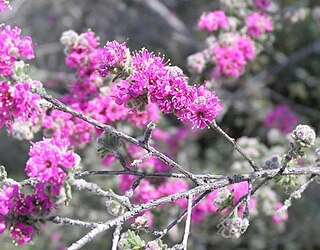
Kunzea preissiana is a flowering plant in the myrtle family, Myrtaceae, and is endemic to the southwest of Western Australia. It is a shrub with hairy branches and leaves, pink to mauve flowers in groups on the ends of shoots, and twenty to thirty stamens about the same length as the petals. It is a widespread, often locally common species across its range.
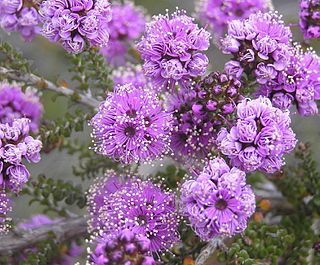
Kunzea recurva is a flowering plant in the myrtle family, Myrtaceae and is endemic to Western Australia. It is an uncommon shrub with small leaves and groups of pink or purplish flowers on the ends of the branches.

Calytrix asperula, commonly known as brush starflower, is a species of flowering plant in the myrtle family Myrtaceae and is endemic to the south of Western Australia. It is a mostly glabrous shrub with linear to narrowly elliptic leaves and cream-coloured to yellow flowers with 40 to 60 yellow stamens in several rows.
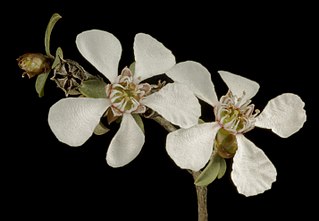
Leptospermopsis erubescens, commonly known as the roadside tea tree, is a species of shrub that is endemic to southwest of Western Australia. It has thin, fibrous bark, egg-shaped leaves, small white flowers and woody fruit.
|range_map = Leptospermum glaucescensDistA24.png |range_map_caption = Occurrence data from AVH }}

















